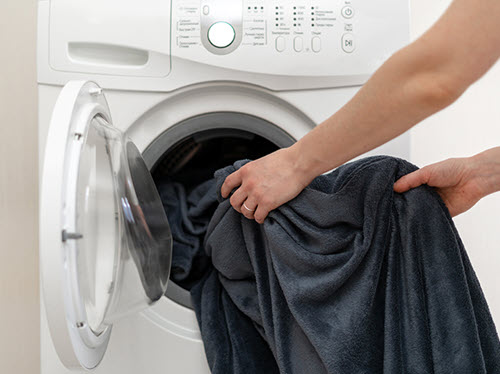Over time, blankets can lose their softness, becoming matted and uncomfortable. This can be caused by a variety of factors such as:
- Improper washing techniques
- Harsh chemicals
- The use of products that may damage the fabric
When a blanket does lose its softness, many want to know how to make a blanket soft again. Luckily, there are a range of simple ways to restore your blanket to its original cozy feel and making it perfect for snuggling.
- Quick Tip#1: One effective and popular method to make a blanket soft again is washing it properly with a mixture of baking soda, white vinegar and your usual detergent.
- Quick Tip #2: Another way is to wash your blanket on a gentle cycle, using the lowest temperature water, then dry it at low heat – this will prevent further damage to the blanket’s texture.
- Quip Tip #3: If you’re going to use detergent, use the mildest detergent when trying to make a blanket soft again.
- Quick Tip #4: Try putting some tennis balls in the dryer to help fluff up and soften your blankets
In this article, we’ll dive into even more expert tips and methods to make a blanket soft again and ensure your favorite blanket remains in prime condition.
In This Article
What are Signs that Your Blanket Needs Softening?
Over time, blankets lose their softness due to a variety of factors such as improper washing, usage of harsh detergents, and fabric aging. As a blanket becomes less comfortable and inviting, you may find it helpful to identify some signs that it needs softening. Here are three distinct signs to look for.
- Your blanket feels matted: One common sign is when your blanket feels matted and no longer soft to the touch. A dull appearance and color fading may also indicate the need for softening. Moreover, if the texture feels rough, itchy, or causes skin irritation, this could be a sign that your blanket has lost its original softness and comfort.
- Unpleasant odors: In addition to the texture and appearance, another indicator that your blanket needs softening is the presence of unpleasant odors. These can arise from improper washing, sweating during sleep, or exposure to allergens, mold, or mildew. A clean and freshly softened blanket should have a pleasant smell that promotes a more enjoyable and relaxing sleep environment.
- Changes to the drape and shape: Furthermore, if the blanket becomes stiff, difficult to fold or no longer drapes comfortably over your body when you sleep, this is a clear indicator. This change in flexibility often results from a buildup of soap residue, hard water minerals, or the overuse of fabric softeners on incompatible fabrics like polyester.
By paying close attention to the texture, appearance, smell, and flexibility of your blanket, you can easily determine if it’s time to take steps towards softening it up again. This process can significantly improve the comfort and sleep quality provided by your blanket.
How to Keep Your Blankets Soft (Washing and Drying Tips)
Before we go into how to make a blanket soft again, it’s important to avoid losing the softness in the first place. Here’s a list of different washing and drying techniques to keep a blanket soft.
Tip #1: Choose the Right Detergent
Using the right detergent is crucial for maintaining the softness of your blanket. Opt for a mild detergent that is specifically designed for delicate fabrics. Be sure to avoid using any detergent that contains bleach or other harsh chemicals, as these can damage the fibers and cause the blanket to lose its softness (spill bleach on your clothes? here’s how to get bleach our of your clothes) .
Use the recommended amount of detergent to ensure proper cleaning without overdoing it, which might make the blanket stiff.
Tip #2: Use Fabric Softeners
While fabric softeners can help enhance the softness of blankets, it’s essential to use them sparingly and wisely. Be cautious with fabric softeners, as too much can cause a build-up on the fibers, resulting in reduced softness over time. You can also consider using baking soda and white vinegar as an alternative for commercial fabric softeners. Adding 1/2 cup of baking soda to the wash, followed by one cup of white vinegar during the rinse cycle, can help achieve a similar result with minimal chemical usage.
Tip #3: Choose the Right Washing Cycle
Always follow the care instructions on the blanket’s label when selecting a washing cycle. As a general guideline, most blankets can be safely washed on a gentle cycle with cold water. This helps to ensure proper cleaning while preserving the fabric’s integrity. For synthetic materials such as nylon, polyester, and acrylic, opt for lukewarm water instead of hot water to avoid damaging the fibers.
If you have a super-soft Minky blanket, read this expert article on how to wash a Minky blanket.
Tip #4: Air-Drying vs. Machine Drying
The drying method you choose can also affect the softness of your blanket. While machine drying is quick and convenient, it can sometimes make blankets less soft, especially when overdone. To preserve the blanket’s softness, consider air-drying when possible. Hanging the blanket outside on a clothesline or laying it flat on a clean surface indoors ensures even drying without any heat-induced damage. If you must machine dry, use the lowest heat setting and consider adding a few clean, dry towels to help speed up the drying process.
How to Make a Blanket Soft Again (2 Sure-Fire Methods)
Method #1: Use Natural Softening Agents
Instead of using harsh chemicals or commercial fabric softeners, consider using natural softening agents to bring back the softness of your blanket. These natural agents are gentle on the fabric and won’t cause any damage.
White Vinegar:
White vinegar is a safe and cost-effective alternative to commercial fabric softeners. The acetic acid in white vinegar helps break down mineral deposits and residue that can cause your blanket to feel stiff or matted. Additionally, it eliminates odors and is good for sensitive skin, as it is an organic product.
To use white vinegar as a natural fabric softener, simply add half a cup to one cup of white vinegar to the washing machine during the rinse cycle. If your machine has a fabric softener dispenser, you can pour the vinegar directly into it. If not, you can use a downy ball or wait until the rinse cycle begins to add the vinegar manually.
Vinegar is gentle on fabrics and can safely be used on a variety of materials, including cotton, wool, and fleece. However, always check the care label of your blanket before using vinegar or any other softening agent.
Baking Soda:
Baking soda, like white vinegar, is another natural and budget-friendly alternative to commercial fabric softeners. Baking soda helps soften fabrics by neutralizing the acidity or alkalinity of the water and breaking down any residue built up on the fibers of your blanket.
To use baking soda as a natural softening agent, add half a cup of baking soda along with your regular detergent during the wash cycle. If your blanket is particularly stiff or matted, you can also try soaking it in a solution of four cups of warm water and one cup of baking soda for an hour before washing it normally.
Baking soda is safe for most materials, but always double-check the care label of your blanket to ensure compatibility. For blankets made of sensitive materials, such as silk or cashmere, it may be best to consult a professional cleaner or follow the manufacturer’s care instructions.
Method #2: Try Brushing and Fluffing
Reviving the softness and fluffiness of an old blanket can be achieved with a few simple techniques. Brushing and fluffing are two essential steps to make your blanket feel soft and cozy again. Implementing these methods can improve the texture and appearance of your favorite blankets, making them more enjoyable to use.
When brushing your blanket, it’s important to follow these tips:
- Be gentle to prevent shedding or damage.
- Use a hand brush or an electric brush, but make sure to brush in the direction of the fabric’s natural grain. This will help lift and separate the fibers, creating a fluffier feel.
- For optimal results, consider brushing your blanket when it’s damp. Damp fibers are more elastic and easier to fluff, which can lead to a more significant transformation. Wet-brushing fleece items can be particularly beneficial in enhancing their softness.
In addition to brushing, another simple method to fluff up your blanket involves using household items during the washing process. One popular method is to use bicarbonate of soda, white vinegar, and your normal washing detergent. Washing your blankets with these items can help deodorize them and enhance their softness and fluffiness.
By incorporating these brushing and fluffing techniques into your blanket care routine, you can extend the life of your favorite blankets and maintain their comfort for years to come.
Proper Storage to Maintain Softness
Proper storage of your blankets is essential to keep them soft and cozy for a long time. Utilize these storage techniques to preserve the softness and texture of your blankets effectively.
- Avoid Damp Environments: Store your blankets in a cool, dry place to prevent moisture from building up, as this can lead to a rough texture or even mold and mildew. Opt for an area with good airflow, such as a closet or a chest with ventilation.
- Fold and Stack: Make sure to fold your blankets neatly before storing them. Stack them with the softest side facing up, which will help maintain their plushness by reducing friction between fabrics.
- Use Blanket Storage Bags: Protect your soft blankets from dust, dirt, and humidity by storing them in breathable blanket storage bags. These bags are designed to preserve the texture and quality of your blankets, preventing them from becoming scratchy.
- Keep Away from Direct Sunlight: Exposure to direct sunlight can cause your blankets to fade and lose their softness. Choose a storage location that isn’t exposed to sunlight or use a covered storage option.
- Don’t Compress or Crush: When storing your blankets, avoid applying excess pressure or weight on them, as this can cause the fibers to become compacted and eventually lose their softness. Instead, store them in a spacious area or use vacuum storage bags to remove excess air without crushing the blanket.
By implementing these proper storage techniques, you can ensure that your blankets remain soft and comfortable for an extended period.
Expert Tips to Keep Different Types of Blankets Soft
Fleece Blankets
Fleece blankets are known for their soft and cozy feel. To maintain their softness, it is essential to pay close attention to the care instructions. Washing fleece blankets with a mild detergent is highly recommended. Furthermore, avoid using fabric softeners, as they can coat the fibers and make them stiffer over time, causing the blanket to lose its softness.
When it comes to drying, avoid high heat settings that can damage the fabric. Instead, use a low heat setting or air dry your fleece blanket. You can also put tennis balls or dryer balls into the dryer to help maintain the blanket’s softness and fluffiness. Remember to keep the drying time short, as over-drying can lead to stiffness and loss of softness.
Cotton Blankets
Cotton blankets are versatile and breathable, making them suitable for various climates. Ensuring that they remain soft involves a gentle washing routine. When washing cotton blankets, use cold or warm water and a mild detergent. Avoid using bleach, as it can break down the fibers, making them stiffer and less comfortable.
For a softening boost, consider adding half a cup of baking soda and vinegar to the wash. This combination will help loosen the fibers and restore softness to the blanket. As with fleece blankets, using a gentle dryer setting or air drying your cotton blanket is the best way to ensure its softness is maintained.
Crotchet Blanket
To maintain your crocheted blanket’s softness, careful washing of a crochet blanket (and drying) is crucial. Use mild detergent and cold water. For machine-washable blankets, use a gentle cycle and consider a mesh laundry bag to avoid damage. For others, opt for a gentle hand wash. Avoid wringing out the blanket, instead roll it in a dry towel to remove excess water.
Fabric softener can help keep your blanket soft, but use it sparingly to avoid fiber buildup and texture alteration. After washing, air dry by laying the blanket flat on a dry towel, reshaping as necessary. This prevents yarn stretching or shrinking, aiding in maintaining its softness.
In between washings, shake out or use a lint roller to remove any dust. If storing, ensure it’s clean, completely dry, and stored in a breathable container away from sunlight and heat. Always check the yarn’s specific care instructions to preserve its softness and overall quality.
Wool Blankets
Wool blankets are excellent for retaining warmth and providing a comfortable sleeping experience. However, caring for wool blankets can be a bit more challenging, as they require special attention to keep them soft and cozy. Firstly, it is crucial to follow the manufacturer’s care instructions for your specific wool blanket. Generally, washing with cold or warm water is preferred.
Hand washing the blanket is the safest and gentlest option to maintain its softness. You can use a mild detergent and add half a cup of baking soda and vinegar for optimal results. If you must use a machine, make sure to select a gentle, low-temperature setting. Always avoid using high heat when drying, as this can cause wool fibers to shrink or become stiff. Instead, air dry the blanket or use a low heat setting in the dryer.
Final Thoughts on How to Make a Blanket Soft Again
In order to keep your blankets soft and enjoyable, proper care and maintenance are essential. It’s crucial to follow the manufacturer’s washing instructions and to use gentle, mild detergents. Avoid using too much detergent, as this can lead to residue buildup, which may contribute to making the blanket stiff.
Improper washing methods could cause damage to synthetic materials like polyester fleece, so it’s important to wash these blankets at the lowest temperature recommended, and avoid high heat in the dryer.
Utilizing natural, chemical-free alternatives like white vinegar and bicarbonate of soda can help restore the softness of your blankets, making them comfortable and inviting once again.
Don’t hesitate to try some of these techniques to bring the softness back to your favorite blankets:
- Laundering using the lowest temperature water
- Using proper amounts of mild detergent
- Adding white vinegar to the washing cycle
- Incorporating bicarbonate of soda and vinegar in your wash
- Using tennis balls in the dryer to fluff up the blanket
Remember, taking good care of your blankets not only ensures their softness, but also prolongs their lifespan. Treating them right will result in many cozy nights spent wrapped in your favorite comfy blanket.






